



As Delhi battles severe air pollution, IIT Kanpur’s cloud seeding plan offers short-term relief by dispersing silver iodide into clouds to trigger rain that clears pollutants. However, its effectiveness depends on weather, and concerns over cost, feasibility, and environmental impact demand long-term pollution control measures.

Copyright infringement not intended
Picture Courtesy: NEWSONAIR
Delhi has approved ₹3.21 crore for five experimental cloud seeding trial runs with IIT Kanpur to combat air pollution.
Cloud seeding is a weather modification technique that increases precipitation by introducing substances into clouds to encourage the formation of water droplets or ice crystals.
Mechanism: When suitable clouds are present, seeding agents such as silver iodide (AgI), sodium chloride (common salt), potassium iodide (KI), or dry ice (solid carbon dioxide) are released into them.
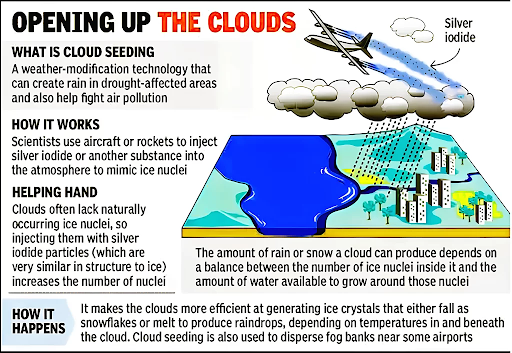
Types of Cloud Seeding:
Wash-out Effect: Artificial rain can "wash out" airborne pollutants, including particulate matter (PM2.5, PM10), sulphur oxides (SOx), and nitrogen oxides (NOx), by bringing them down to the ground.
Scavenging: As raindrops fall, they absorb and physically remove pollutants from the atmosphere, improving air quality.
Moisture Enhancement: Induced rainfall can increase atmospheric moisture and reduce the thickness of smog, making the air appear clearer.
|
Cloud seeding offers immediate, temporary relief from severe air pollution, aids in disaster mitigation like fog dispersal at airports, and suppresses hail to protect crops. |
Effectiveness Debate
Effectiveness of cloud seeding for reducing air pollution is scientifically debated, with studies showing mixed and often marginal results.
Dependency on Meteorological Conditions
Cloud seeding requires existing, moisture-laden clouds with sufficient humidity and vertical air motion.
Delhi's peak pollution in winter often lacks the required conditions, making cloud seeding difficult or ineffective, as acknowledged by experts.
Environmental and Health Concerns:
Cost-Effectiveness and Resource Allocation
Cloud seeding operations are expensive (₹55 lakh per trial in Delhi). Critics argue that given the temporary relief (1-2 days) and scientific uncertainties, these funds could be better used for proven long-term solutions to pollution.
Ethical and Legal Quandaries:
Risk of Diverting Attention from Root Causes
Scientists warn that cloud seeding offers only temporary relief and risks diverting policy attention and resources from fundamental pollution sources like vehicular emissions, industrial discharge, construction dust, and stubble burning.
|
What is India's Experience with Cloud Seeding and its Current Stance? India has experimented with cloud seeding since the 1970s, with initial attempts by the Indian Institute of Tropical Meteorology (IITM) in Tamil Nadu (1973) and Mumbai (1974) for drought mitigation. Karnataka launched the "Varshadhare" programme in 2017 for rainfall enhancement. The IITM's Cloud Aerosol Interaction and Rainfall Enhancement Experiment (CAIPEEX) in Solapur, Maharashtra, reported an 18-46% increase in rainfall in seeded clouds in some areas. However, India's recent focus on cloud seeding for air pollution, particularly in Delhi, marks a new chapter. |
Prioritize Root Cause Solutions
Implement stringent emission standards for industries and vehicles, promote public transport, adopt sustainable agricultural practices to curb stubble burning, enhance waste management, and enforce dust control measures at construction sites.
Invest in Scientific Research
More stringent, regulated, and open research is required to understand cloud seeding's effects on air quality across various climates, with an emphasis on its immediate and long-term environmental impacts.
Develop Robust Regulatory Frameworks
Establish clear national guidelines for weather modification technologies, addressing environmental impact assessments, liability, resource sharing, and ethical concerns.
Regional Cooperation
Encourage collaboration among states and with neighboring countries to address transboundary air pollution and potential impacts of weather modification.
Public Awareness and Engagement
Educate citizens about the sources of pollution and encourage their participation in mitigation efforts.
Integrated Air Quality Management
Adopt a holistic strategy that combines technological interventions, policy reforms, regulatory enforcement, and citizen action to ensure breathable air for all.
Cloud seeding should be considered only as a last-resort, supplementary measure under specific meteorological conditions, not a standalone solution.
Cloud seeding is an unreliable, temporary, and costly fix for pollution. Sustainable progress demands enforcing regulations, implementing long-term strategies, and controlling emissions, addressing root causes over short-term tech interventions.
Source: NEWSONAIR
|
PRACTICE QUESTION Q. What is cloud seeding? Is it a sustainable practice for long-term environmental management? 250 words |
Cloud seeding is a scientific method of weather modification that improves a cloud's ability to produce rain or snow. It involves dispersing substances, known as seeding agents, into clouds. These agents act as a base, or nuclei, for water droplets or ice crystals to form and grow large enough to fall as precipitation.
The method works by mimicking the natural process of precipitation. Seeding agents are dispersed into clouds via aircraft, rockets, or ground-based generators. These particles attract moisture, causing cloud droplets or ice crystals to combine and grow. When they become heavy enough, they fall as rain or snow.
Cloud seeding disperses chemical agents into clouds to induce or enhance precipitation (artificial rain), generate snow, suppress hail, or clear fog. While often used interchangeably, cloud seeding is the method, and artificial rain is the result.
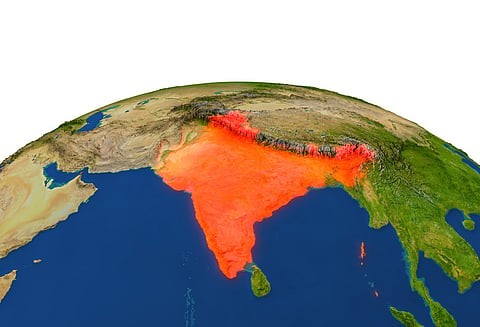
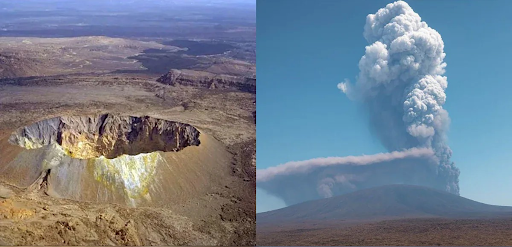


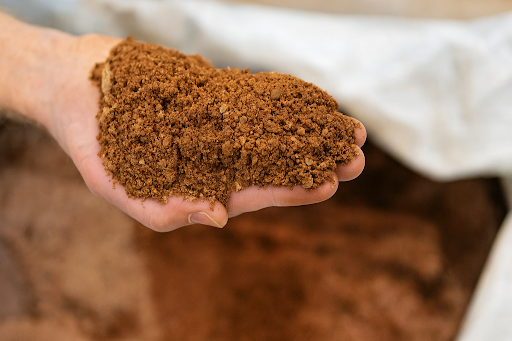

© 2025 iasgyan. All right reserved